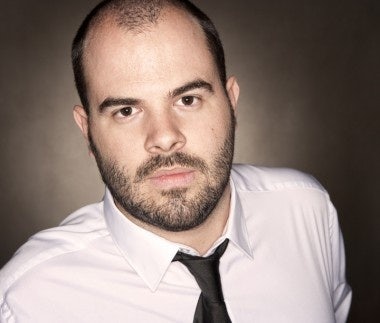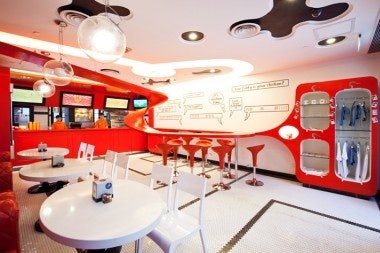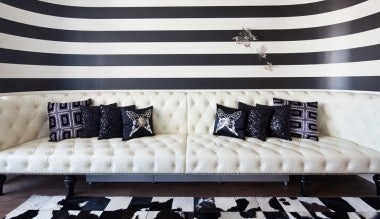Jing Daily Speaks With China-Based Designer Thomas Dariel#

Thomas Dariel, founding partner of design firm Dariel & Arfeuillere
Moving to Shanghai from Paris in 2006, designers Thomas Dariel and Benoit Arfeuillere have quickly made names for themselves in the city's thriving design community. Over the past five years, the duo's design firm, Lime388--which they're currently rebranding as Dariel & Arfeuillere--has been involved in some of the most striking and instantly recognizable interiors in Shanghai, from their work for famed Australian-Greek chef and restaurateur David Laris (Yucca, Funky Chicken, 12 Chairs) to the downtown golf lounge Ultra 18 and Fame nightclub.
Rex Jiang of Jing Daily recently met up with Thomas Dariel to discuss his firm's current projects, the changing tastes of Shanghai's design-savvy urbanites, and his plans for the future.
Jing Daily (JD): Can you tell us a little about your design firm?#
Thomas Dariel (TD)#
: Our design company, Lime388, opened in 2006, but now we’re changing the firm name to [Dariel & Arfeuillere] because our egos have gotten bigger. [Benoit Arfeuillere and I are] both from Paris, which is where we studied, and we came here because it was the “Year of China in France” and “Year of France in China”, and our governments asked us to come up with a project in terms of design for Qingdao and Shanghai. We thought it was a great opportunity for us to go ahead and open our company here because with the economy booming and all the connections, I felt there was a lot of potential, so we decided to stay here. Now our company has been around for over four years, and a lot of things can happen in four years, especially in China.
Four years in China is like 20 years in Europe. (laughs)
JD: Were you already planning to come to China before the opportunity presented itself?#
TD#
: Yeah. I came to China 12 or 13 years ago and was really impressed by it. And I promised myself I’d come back after my studies, so that’s why it was such a perfect opportunity when the [French] government commissioned us. We just jumped on it. Actually, my partner was originally planning to go to Finland, and I spent hours convincing him to come to China instead.
It was my dream in a way because, you know, it’s a question of economic context. That’s not the only reason we’re in China, but here I found many interesting projects, and I think to become a better designer you need to work on good projects.

The interior of David Laris's Yucca restaurant
JD: China 12 years ago must have been very different from what it’s like now. How has the rapid growth changed Chinese tastes?#
TD#
: It’s changed them a lot, of course. Over the past four or five years I’ve seen an evolution – for example, when I arrived there was a real fear of copying, but I think this time is over. I think people have probably copied me, but to me that just means I’m good. Anyway, I think the era of copying is over. And now I can see an evolution in taste among my clients in terms of what they want. Now I can propose more crazy extravagances from around the world. [The clients] are less traditional, more open minded, looking for something new.
The biggest difference is this, there are two kinds of designers: those who follow the expectations of the clients, whose work is 70-80 percent derived from the client versus 20 percent from the designer. Then there’s the other kind, of designer, which is what I think we are, who says, "I don’t give a damn about what you want". It’s about having a signature. If you don’t like my signature, find someone else. I’m young, and every day I have new ideas and think of ways to develop my language more and more. My design is my signature. It’s very important to me. And just to finish your question, now there are more and more clients who want my signature, and fewer who say, "I want 'this-and-this-and-this’".
JD: Have you always worked this way, or was it different when you first founded your firm?#
TD#
: When I first started out with clients, I was a bit more scared and didn’t want to lose them, but I’m just too disobedient. (laughs) So in the first meeting, I'd be very nice, in the second, I'd be nice but not too nice, and then I'd just do what I wanted to do.
Today, so many people claim to be designers. They download some software and say they can use Photoshop and develop a logo, but for us it’s our signature and our job. We spent lots of time studying, we’ve got degrees, experience, background. Our job is very important to us.
JD: Would you say China has, on the whole, more daring projects? Projects that are more unconventional or bold in design.#
TD#
: Yeah, but there’s a reason for that, it’s because the cost structure is different. In Paris, for example, you can design crazy, unconventional stuff but when you receive the bill, no one wants to pay it. Here, sometimes I say to myself, maybe I’ll never go back to Paris because we’ve gotten used to the construction fees being so affordable. (laughs) If you do the same [projects] in Paris, it’s like (mimes choking).

Interior of The Funky Chicken
JD: Who are your clients now? Mostly private clients?#
TD#
: Our clients are all very different. We’re working with Hermès, and we're working with a Chinese private investor on a boutique hotel. That’s one I’m really proud of. You know, designers have big egos, and we recently won a competition for a design project in Zhouzhuang [between Suzhou and Shanghai]. It’s something completely different. It’s a very old, 16th century building, very beautiful, with lots of courtyards. They are going to turn it into a boutique hotel, and I feel so glad because it’s part of Chinese history and they’re giving it to me – it’s like, imagine us giving a Chinese designer a very old building in Paris. I feel very proud that they trust me [with it]. They want to do something very exclusive there in Zhouzhuang, which is really beautiful.
We’re also doing some projects in Macau, a spa for a Japanese company, working with [restaurateur] David Laris, who trusts me enough to give me lots of projects and asks me to create new concepts. We also finished the first Johnnie Walker House, which is really exclusive. You can’t just go there, you have to be invited, and it’s amazing. Even the water at the bar is imported from Scotland. We also have a fashion hotel [we’re working on]. We’re always going, going. We “keep walking,” as Johnnie Walker says. (laughs)
JD: So how big is your firm now?#
TD#
: We’ve got 15-20 people currently. Not small, not large, the perfect size to do the kinds of projects we do.
JD: Back to your clients, what would you say the breakdown is in terms of local Chinese vs. foreigners?#
TD#
: 50/50. It's not because we’re foreigners, we have Chinese clients, we have famous foreign clients. It's something I'm proud of. When someone on my team who's a foreigner here teaches a Chinese client about the price of marble in China, I'm happy because, honestly, it's really difficult to be good in this market as a foreigner. Since I don't look Chinese, [for some Chinese clients] it's trendy to have a designer for Paris, you take some pictures with them, drink some cocktails, then it's "leave us alone and we'll discuss between Chinese." Because the client is afraid the project will be expensive [with a foreign designer], since they think we don't understand the market or the process and that we don't have guanxi, we don't know what things cost, which is wrong.
We've spent the last four years building relationships, learning everything about the market, figuring how to get the best prices in terms of furniture, marble and so on. But that's just something we have to prove to the Chinese client.

Private apartment in Shanghai's Xintiandi neighborhood
JD: So have you noticed an increase in local clients coming to you?#
TD#
: Yeah. I mean, we're in China so we need Chinese clients. And for me, I didn't come to the Chinese market to become a Chinese designer. I came to Shanghai because, like people 30 or 40 years ago went to New York, I feel that it's a business city becoming international. I know this city will become crazy, and out of my own ambition I came to Shanghai because I know it'll become an international city within 10 years. By then, people will say it's normal, even trendy, to have a design firm in Shanghai. Like how it's trendy to be in a city like New York or Milan.
JD: We've covered this a little already, but I want to get back to current projects. What are you most excited to be working on right now?#
TD#
: Zhouzhuang. The Zhouzhuang project. I have to tell you that the boutique hotel there will be so different. I'm really happy to be working on that project because people there are so nice.
Another project is a wine lounge in Shanghai that'll open in two weeks, called Kartel. It's going to be three stories tall, located on Shangyang Lu downtown. They'll have the biggest collection of wine [in Shanghai], with cheese. Kartel will be pretty cool. The terrace has a 360 degree view. The concept for that project is "destroy chic" -- I was looking for a concept, and since this was a rush project I said, okay, let's start with demolition. And we gutted everything, then installed expensive chairs and stuff, so I call it "destroy chic." It sounds easy, but it was actually quite difficult.
JD: You've designed David Laris restaurants like Yucca, Funky Chicken, and The Fat Olive. The Laris restaurants are all very different, so how much freedom did he give you in terms of design?#
TD#
: Carte blanche. He trusted us enough to say, this is what I want [for the restaurant], and I could do whatever I wanted.

Interior of The Fat Olive
JD: So you design the restaurant, he designs the food afterwards.#
TD#
: Three things are important in the restaurant business: the food, the design and the service. If you miss out on one of these things, it doesn’t work.
JD: Do you plan on expanding your firm to other locations?#
TD#
: Yeah, but the thing is to develop our signature name. Our headquarters will be in Shanghai but we plan to look out for other opportunities. I still have to convince my investors, but we're planning to open something in a very hot city next year. But not in Asia and not in Europe. (pauses) And not in Africa. (laughs)
It's all about developing a name, and we plan to launch a range of furniture and products, then place our products.
JD: What can you tell us about these products you're thinking of selling?#
TD#
: We're going to launch a series of carpets, furniture -- chairs, tables and stuff -- with different clients. We're working on that now. We also want to launch our own brand of furniture under our own name.
JD: Any timeline?#
TD#
: Yes, before the end of the year.